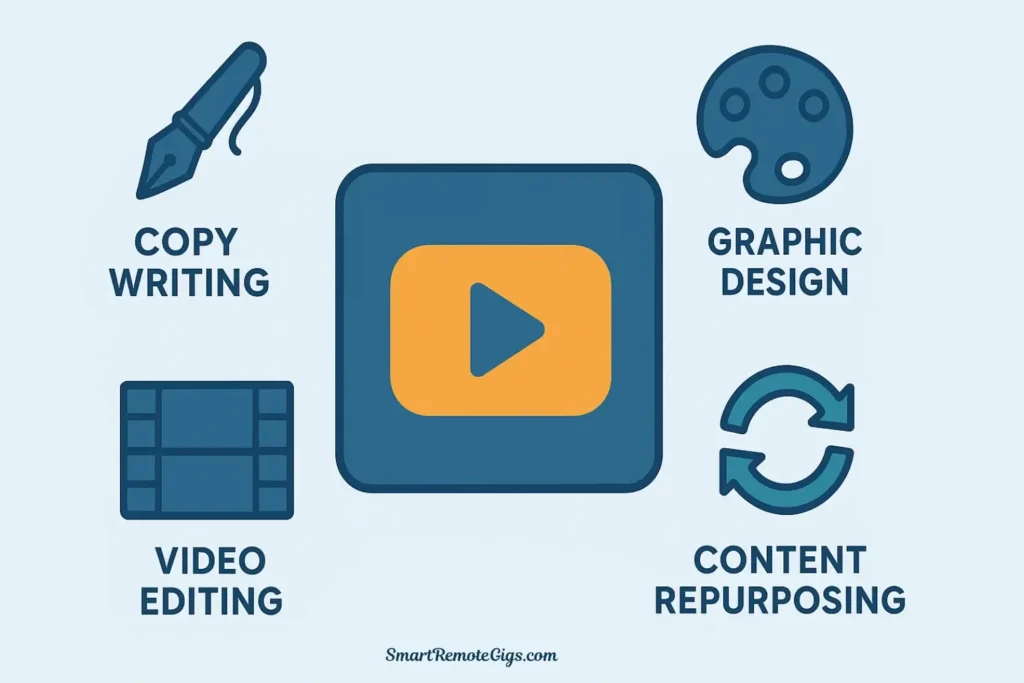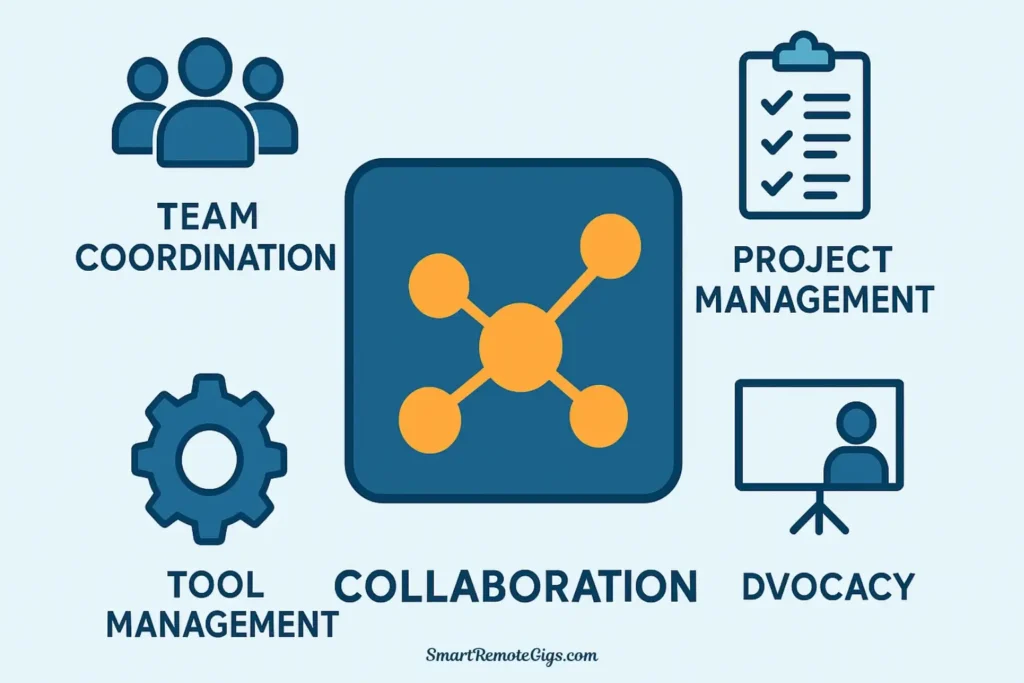If you’ve ever told someone you’re interested in becoming a social media manager, you’ve probably heard some version of: “Oh, so you just post on Instagram all day?” It’s a common misconception that reveals just how misunderstood this profession is.
The reality is far more complex—and far more interesting. What does a social media manager do varies significantly depending on company size, industry, and team structure. At a startup, you might be a one-person band handling everything from strategy to graphic design. At an enterprise company, you might specialize in just one platform or focus exclusively on paid advertising.
But despite this variation, there are core responsibilities that define the role across organizations. This guide breaks down the social media manager roles and responsibilities into five fundamental pillars, giving you a clear picture of what the job actually entails—and whether it’s the right career path for you.
Whether you’re considering entering the field, hiring your first social media manager, or simply curious about what these professionals do all day, this comprehensive breakdown will give you the definitive answer.
The 5 Pillars of Social Media Management
Every social media manager’s day-to-day work can be organized into five core functions. While the time spent on each varies by role and seniority level, these pillars represent the fundamental duties of a social media manager across industries and company types.
Think of these as the foundational skill sets you’ll need to develop and the primary areas where you’ll add value to an organization. Let’s examine each in detail.
1. Strategist & Planner

Before a single post goes live, effective social media managers operate as strategists. This is the “thinking” work that happens behind the scenes—the foundation that makes everything else possible.
Core Strategic Responsibilities:
Conduct Audience Research: Understanding who you’re talking to is paramount. Social media managers analyze demographic data, psychographic information, and behavioral patterns to build detailed audience personas. This means diving into platform analytics to understand follower age ranges, geographic locations, active hours, and content preferences. It also involves monitoring conversations, reading comments, and identifying the pain points, questions, and interests that drive your audience’s engagement.
Perform Competitive Analysis: You need to know what’s happening in your competitive landscape. Social media managers regularly audit competitors’ social presence, identifying what content performs well for them, what platforms they prioritize, what engagement tactics they use, and where gaps exist that your brand can fill. This isn’t about copying—it’s about understanding the broader conversation in your industry and finding your unique angle.
Set Goals & KPIs: Strategy without measurement is just guessing. Social media managers establish clear, measurable objectives aligned with broader business goals. This might mean setting targets for follower growth, engagement rate, website traffic from social, lead generation, or brand awareness metrics. According to HubSpot’s State of Marketing Report, 72% of marketers say proving ROI is their top priority, making goal-setting an increasingly critical function.
Develop Content Calendars: Strategic planning manifests in the content calendar—a roadmap that ensures consistent posting, balances content types, aligns with marketing campaigns, and anticipates key dates (product launches, holidays, industry events). Social media managers typically plan content 2-4 weeks in advance, though they remain flexible enough to pivot for timely opportunities or breaking news.
Create Brand Voice Guidelines: Maintaining consistency across platforms and team members requires documented standards. Social media managers often develop or refine brand voice guidelines that define tone, language choices, response protocols, and visual standards. This becomes especially important as teams grow or when working with freelancers and agencies.
Reality Check: Strategy work often happens in intense planning sessions quarterly or monthly, rather than daily. However, strategic thinking should inform every post you create and every metric you track. Junior roles spend less time on pure strategy, while senior positions might dedicate 30-40% of their time to strategic planning.
2. Content Creator & Curator

This is what most people imagine when they think of social media management—the visible, creative work of producing and sharing content. But modern content creation is far more sophisticated than simply posting random updates.
Core Content Responsibilities:
Write Compelling Copy: Every caption, tweet, LinkedIn post, and comment requires thoughtful writing. Social media managers craft copy that captures attention in crowded feeds, communicates key messages concisely, maintains brand voice consistently, includes strategic calls-to-action, and incorporates relevant keywords and hashtags. This writing must adapt to each platform’s norms—what works on LinkedIn won’t work on TikTok, and vice versa.
Design Graphics: While not typically trained graphic designers, most social media managers create visual content using tools like Canva, Adobe Creative Cloud Express, or Figma. This includes designing social media graphics that align with brand standards, creating templates for consistent visual identity, producing infographics that simplify complex information, and adapting existing marketing materials for social formats.
Produce & Edit Video Content: Video has become non-negotiable, particularly with the rise of TikTok, Instagram Reels, and YouTube Shorts. Social media managers increasingly handle basic video work: shooting simple videos on smartphones or webcams, editing footage using apps like CapCut, Adobe Premiere Rush, or InShot, adding captions, music, and effects, and optimizing videos for each platform’s specifications (aspect ratios, length limits, caption placement).
Source User-Generated Content (UGC): Smart social media managers don’t create everything from scratch. They actively source and curate content from customers, brand advocates, industry influencers, relevant news sources, and employee ambassadors. This requires developing systems for tracking permissions, maintaining organized content libraries, and crediting creators appropriately.
Repurpose Existing Content: Efficiency matters in content creation. Social media managers regularly repurpose existing assets: turning blog posts into carousel graphics or thread series, extracting quote graphics from podcasts or videos, breaking long-form content into bite-sized social posts, and adapting content across multiple platforms with platform-specific adjustments.
Stay Current with Trends: The social media landscape evolves constantly. Effective managers dedicate time to monitoring emerging content formats, identifying relevant trending topics or challenges, understanding new platform features, and adapting trends to fit brand voice and values (not every trend is appropriate for every brand).
Reality Check: Content creation often follows a batching workflow—dedicating specific blocks of time to creating multiple pieces of content rather than creating one-off posts throughout the day. Many managers set aside 1-2 dedicated “content creation days” per week for maximum efficiency.
3. Community Manager & Communicator

Social media isn’t a broadcast channel—it’s a conversation. Community management represents the human, relationship-building side of the role, and it’s often what distinguishes good social media managers from great ones.
Core Community Management Responsibilities:
Respond to Comments & Messages: Active engagement means promptly responding to comments on your posts, answering questions in direct messages, addressing mentions and tags, and participating in relevant conversations in your feed. This isn’t just customer service—it’s relationship building that increases loyalty, provides valuable customer insights, and signals to platform algorithms that your content is generating genuine engagement.
Drive Proactive Engagement: Community management isn’t passive. Social media managers actively engage with their community by liking and commenting on followers’ content, participating in industry conversations, supporting brand advocates and loyal customers, and building relationships with complementary brands and influencers.
Manage Online Communities: Many brands maintain dedicated communities beyond their main social profiles—Facebook Groups, LinkedIn Groups, Discord servers, or branded forums. Social media managers often moderate these spaces by establishing and enforcing community guidelines, sparking discussions and keeping conversations active, connecting community members with each other, and identifying power users who can become brand advocates.
Conduct Social Listening: Understanding what people are saying about your brand, competitors, and industry requires active monitoring. Social media managers use tools like Hootsuite, Sprout Social, or Brandwatch to track brand mentions (even untagged ones), monitor competitor activity and sentiment, identify emerging trends or customer concerns, and spot opportunities for timely engagement or content creation.
Handle Crisis Management & Issue Resolution: Not all interactions are positive. Social media managers handle negative comments professionally and empathetically, de-escalate potentially viral complaints before they spread, coordinate with customer support or PR teams when issues arise, and know when to move sensitive conversations to private channels.
Build Influencer & Partnership Relationships: Relationships extend beyond customers. Social media managers often identify and reach out to potential influencer partners, negotiate collaboration terms and content requirements, coordinate with partners on campaign execution, and maintain ongoing relationships with brand advocates.
Reality Check: Community management is one of the hardest aspects of the role to outsource or automate. It requires genuine human judgment, empathy, and brand knowledge. Expect to spend 15-25% of your time on community interactions, with spikes during campaigns or when issues arise.
4. Analyst & Reporter

Data drives modern social media strategy. The ability to interpret metrics, identify patterns, and translate insights into action separates strategic social media managers from those who simply post content and hope for the best.
Core Analytics Responsibilities:
Track Performance Metrics: Social media managers monitor a wide range of metrics across platforms: reach and impressions (how many people see your content), engagement rate (likes, comments, shares, saves relative to reach), follower growth and audience demographics, click-through rates to website or landing pages, and conversion metrics (leads, sales, sign-ups attributed to social).
Create Performance Reports: Regular reporting keeps stakeholders informed and strategies data-driven. Social media managers typically create weekly snapshot reports for internal teams, monthly comprehensive reports for leadership showing progress toward goals, quarterly strategic reviews analyzing trends and recommending adjustments, and campaign-specific reports measuring the ROI of particular initiatives.
Conduct A/B Testing: Optimization requires experimentation. Social media managers systematically test posting times to identify when audience is most active, content formats to determine what resonates most, caption lengths and styles, hashtag strategies, visual styles and color schemes, and calls-to-action to maximize desired behaviors.
Translate Data into Actionable Insights: Collecting data is meaningless without interpretation. The real skill is identifying why certain content outperforms others, recognizing patterns in audience behavior, connecting social media metrics to broader business outcomes, and recommending strategic pivots based on performance data.
Benchmark Against Competitors: Understanding your performance in context requires comparison. Social media managers track how their metrics compare to competitors, identify gaps where competitors are outperforming them, spot opportunities where the brand can differentiate, and set realistic goals based on industry benchmarks.
Demonstrate ROI Attribution: Increasingly, social media managers must connect their work to revenue. This means using UTM parameters to track traffic sources, implementing pixels and conversion tracking, coordinating with sales teams to attribute social influence on deals, and calculating customer acquisition costs for social channels.
Reality Check: Analytics work typically happens in dedicated blocks rather than continuously. Many managers dedicate a few hours weekly to dashboard monitoring and a full day monthly for comprehensive reporting. Tools like Google Analytics, platform-native analytics, and social media management platforms make this work more efficient, but human interpretation remains essential.
5. Collaborator & Project Manager

Social media doesn’t exist in isolation—it touches every part of a business. Effective social media managers operate as connectors who coordinate across teams and manage complex, multi-stakeholder projects.
Core Collaboration Responsibilities:
Coordinate Cross-Functional Teams: Social media managers regularly work with marketing teams to align social with broader campaigns, content creators to adapt blog posts, videos, or podcasts for social, product teams to develop launch strategies and gather customer feedback, sales teams to support social selling initiatives and share leads, customer support to coordinate on complaint resolution and FAQs, and executives to amplify thought leadership content.
Manage Influencer & Agency Relationships: When working with external partners, social media managers develop campaign briefs and creative direction, negotiate contracts and compensation, coordinate content calendars and deadlines, review and approve content before publication, and measure campaign performance and ROI.
Lead Project & Campaign Management: Major initiatives require sophisticated coordination. Social media managers develop campaign timelines with clear milestones, assign tasks and manage freelancers or junior team members, track deliverables and ensure deadlines are met, coordinate asset creation across multiple contributors, and manage campaign budgets for paid promotion or influencer partnerships.
Maintain Tool & Platform Stack: Social media managers typically select and manage the tech stack: social media management platforms (Hootsuite, Buffer, Sprout Social), design tools (Canva, Adobe Creative Cloud), analytics platforms (Google Analytics, platform-native insights), project management tools (Asana, Trello, Monday.com), and content libraries or digital asset management systems.
Stay Educated & Advocate for Resources: The role requires continuous learning and internal advocacy. Social media managers stay current on platform updates and algorithm changes, attend industry conferences or webinars, participate in professional communities, and advocate internally for budget, headcount, or resources needed to execute strategy effectively.
Reality Check: Collaboration and project management become increasingly central as you advance in your career. Entry-level roles might spend 10% of time on coordination, while directors or heads of social might spend 40-50% of their time in meetings, managing stakeholders, and coordinating cross-functional initiatives.
How Being “Remote” Changes the Job
While the core social media manager tasks remain consistent whether you work in an office or from home, remote work does introduce specific considerations that shape how you execute these responsibilities.
1. Written Communication Becomes Paramount
Remote social media managers rely heavily on asynchronous communication. This means writing exceptionally clear project briefs, documenting decisions and rationale thoroughly, overcommunicating status updates proactively, and creating comprehensive process documentation for team members. The ability to articulate strategy, explain creative choices, and report results in writing becomes as important as the social media work itself.
2. Self-Discipline is Non-Negotiable
Without physical office structure, remote social media managers must create their own systems for maintaining consistent posting schedules despite varying personal schedules, setting boundaries between work and personal time, staying productive during content creation sessions, and managing multiple platforms without constant supervision.
3. Asynchronous Workflows Become Essential
Remote teams often span time zones, making real-time collaboration challenging. Successful remote social media managers develop content approval workflows that don’t require synchronous meetings, use project management tools to maintain visibility across the team, record video updates or Loom walkthroughs instead of requiring meetings, and build buffer time into schedules to accommodate delayed responses.
4. Technology Proficiency Expands
Remote work requires comfort with digital tools for video conferencing (Zoom, Google Meet), project management (Asana, Trello, Notion), cloud storage (Google Drive, Dropbox), social media scheduling (Buffer, Hootsuite), and screen recording (Loom, Snagit) for training or feedback.
5. Relationship Building Requires Intentional Effort
Community building and team collaboration require intentional effort remotely. This means scheduling regular video check-ins with managers and collaborators, participating actively in team Slack channels or communication platforms, creating opportunities for informal connection with colleagues, and being proactive about asking questions and seeking feedback.
The Career Path: Where Does This Role Lead?
Understanding what social media managers do becomes even more valuable when you see how these responsibilities evolve throughout your career. Here’s how the role typically progresses:
Social Media Coordinator (Entry-Level, 0-2 years)
At this level, you’ll focus primarily on execution—posting scheduled content, responding to comments and messages, creating graphics in Canva, and generating basic performance reports. You’ll work under the direction of a manager or strategist who provides the overall direction while you handle day-to-day tasks.
Social Media Manager (Mid-Level, 2-5 years)
As a manager, you’ll own strategy for specific platforms or campaigns, create content calendars independently, analyze performance and make strategic adjustments, manage freelancers or junior team members, and collaborate with other departments on campaigns. This is where you transition from executing others’ strategies to developing your own.
Senior Social Media Manager / Strategist (5-8 years)
Senior roles emphasize strategic thinking and cross-functional leadership. You’ll develop comprehensive social media strategies aligned with business goals, lead major campaigns or platform launches, manage budgets for paid social or influencer partnerships, present strategies and results to executive leadership, and mentor junior team members and shape department culture.
Social Media Director / Head of Social (8+ years)
At the director level, you’re a strategic executive. Responsibilities include setting vision for the entire social media function, managing a team of managers and specialists, allocating budget across platforms and initiatives, representing social media in C-suite discussions, and identifying emerging platforms and opportunities for competitive advantage.
Specialized Paths
Some social media professionals specialize rather than moving into management. Options include becoming a paid social advertising specialist, creator/influencer strategist, social media consultant serving multiple clients, platform specialist (e.g., LinkedIn expert), or social commerce specialist focused on driving revenue.
The beauty of the social media career path is its flexibility. You can climb into leadership, specialize deeply in one area, move into freelance or consulting work, or transition into adjacent fields like content marketing, digital strategy, or community management.
Is This Career Right for You?
Now that you understand the comprehensive answer to what does a social media manager do, you can make an informed assessment about whether this career aligns with your interests and strengths.
This role is ideal for people who are genuinely curious about human behavior and online trends, comfortable with both creative work and data analysis, able to juggle multiple priorities and shift gears quickly, strong writers who can adapt voice and tone for different contexts, and energized by fast-paced environments where change is constant.
It may not be the right fit if you prefer deeply focused, uninterrupted work on single projects, feel drained by constant communication and relationship management, prefer roles with highly predictable daily routines, dislike working on tight deadlines or managing competing priorities, or struggle with creative thinking and strategic problem-solving.
The most successful social media managers balance analytical and creative thinking, maintain genuine curiosity about people and culture, embrace continuous learning and adaptation, communicate clearly and empathetically, and understand business fundamentals beyond just marketing.
Ready to see these responsibilities in action? Explore our A Day in the Life of a Remote Social Media Manager guide to understand how these five pillars come together in a typical workday, from morning planning sessions to evening analytics reviews.
From Understanding to Action: Your Next Step
Now that you have a comprehensive answer to “What does a remote social media manager do?”, the next logical question is, “How do I become one?”
Understanding the role is the first crucial step. If you’ve read through these responsibilities and feel energized and ready to pursue this dynamic career, you need an action plan. Our complete pillar guide provides the entire roadmap—from developing these exact skills to building a standout portfolio and landing your first remote job.
➡️ Your Complete Roadmap: How to Become a Remote Social Media Manager (The Complete 2025 Guide)






